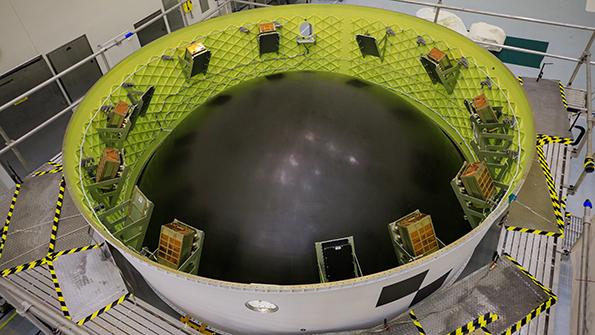Artemis I Cubesat Probes Push Envelope For Deep-Space Exploration

Credit: Cory Huston/NASA
As small satellites become more capable and cheaper, NASA is preparing to launch 10 six-unit cubesats as secondary payloads aboard the Space Launch System’s (SLS) Artemis I mission. If successful, the missions may open the door to exploration of the Solar System with shoebox-size spacecraft. Here is the lineup of cubesats hitching rides aboard the SLS.
- BioSentinel is designed to quantify DNA damage from the radiation environment in deep space. The satellite, built by NASA’s Ames Research Center, is equipped with sensors to monitor radiation effects on two strains of yeast, with particular attention on genetic mechanisms shared with human cells that affect DNA damage and repair. One portion of yeast will be exposed to a radiation storm. The cubesat will be sent on a lunar flyby trajectory and then enter a heliocentric orbit.
- The CubeSat to study Solar Particles (CUSP), developed by the Southwest Research Institute and NASA’s Goddard Space Flight Center, will travel to a solar orbit to study radiation from the Sun in the hours before it reaches Earth. The purpose of the mission is to help determine whether a future network of similar small satellites would be of value in monitoring space weather. CUSP sensors will measure low-energy suprathermal particles—which are charged ions and electrons that move at speeds 2-200 times faster than the thermal plasma of the solar wind—as well as high-energy solar particles and the strength and direction of the Sun’s interplanetary magnetic field.
- The Equilibrium Lunar-Earth point 6U Spacecraft (Equuleus), a collaboration between the Japan Aerospace Exploration Agency (JAXA) and the University of Tokyo, will image the Earth’s plasma sphere—the inner region of the magnetosphere—which shrinks and expands with changes in space weather activity. Equuleus will try to reach an Earth-Moon libration orbit, where the gravitational pulls of the Sun, Earth and Moon are balanced. It will use the water-propelled Aquarius warm gas propulsion system.
- The Outstanding Moon Exploration Technologies demonstrated by Nano Semi-Hard Impactor (Omotenashi), sponsored by JAXA, is planned to demonstrate a small surface-probe lunar-landing capability using an inflatable airbag and shock absorption system made of crushable material and an epoxy filling. It is also planned to deploy a sensor to measure the radiation environment near the Moon’s surface.
- The Lunar Polar Hydrogen Mapper (LunaH-Map) is an Arizona State University-led effort to assess from orbit the distribution and concentrations of hydrogen across the Moon’s south pole, a region rich in subsurface water ice deposits. LunaH-Map will put itself into an elliptical orbit that passes as close as 5-12 mi. from the lunar surface. It will attempt to collect data for more than 60 days and demonstrate auto-navigation software.
- LunIR is a Lockheed Martin-led lunar flyby mission equipped with a miniature infrared sensor to gather data about the composition of lunar surface materials, thermal signatures, the presence of water ice and potential landing sites. The spacecraft’s miniature high-temperature midwave infrared sensor can image the Moon night or day and at higher temperatures without overheating, using its compact microcryocooler. The bus, made by Terran Orbital, will use a “Moon camera” vision-guidance system and an algorithm developed by Lockheed to locate targeting points.
- The Near-Earth Asteroid Scout (NEA Scout) is equipped with a solar sail for a two-year mission to gather high-resolution imagery of the asteroid 2020 GE, which, at just under 60 ft. in diameter, will be the smallest object in its class to be studied up close. NEA Scout is planned to become the first cubesat to visit an asteroid and the first spacecraft to use a solar sail in deep space. The sail, which is made of a thin aluminized polymer, will unfurl to 925 ft.2 The satellite is a project of NASA’s Marshall Space Flight Center and Jet Propulsion Laboratory.
- Lunar IceCube is planned to navigate to a highly inclined, elliptical lunar orbit with a low point of 62 mi. above the Moon’s surface. Propelled by electric propulsion, the Morehead State University-led mission will prospect for water and other volatiles with an infrared spectrometer known as the Broadband InfraRed Compact High-Resolution Exploration Spectrometer, or Birches.
- ArgoMoon, an Italian Space Agency mission to demonstrate high-definition cameras and advanced imaging software, will attempt to image the SLS upper stage, Earth and the Moon. ArgoMoon is equipped with a micropropulsion system that relies on a green monopropellant and cold gas to provide attitude control and orbital maneuvering. The spacecraft also will test artificial-intelligence-based algorithms that will continuously monitor the satellite’s health.
- Team Miles is a NASA Cube Quest Challenge project led by Miles Space and software developer Fluid & Reason that will demonstrate a plasma propulsion technology. It will attempt to travel autonomously to a distance of nearly 60 million mi. from Earth. The spacecraft will use a software-defined radio to communicate with Earth.


